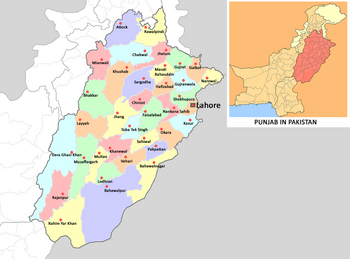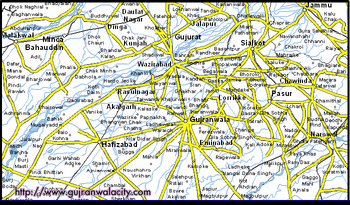Gujrat


Gujrat (Hindi:गुजरात, Urdu/Punjabi: گجرات) is a city and district in the Punjab province of Pakistan. Gujrat is situated on the bank of Chenab River, situated about 120 kilometres north of Lahore, the capital city of Punjab province, and 150 kilometres from Islamabad, the capital of Pakistan.
Tahsils in the District
Jat clans in Gujrat District
According to 1911 census, the following were the principal Muslim Jat clans in Gujrat District[1]:
Awan (1,780), Bagril (586), Bains or Wains (596), Bangial (1,679), Chadhar (976), Cheema (2,572), Chauhan 726, Dhillon (692), Dhotar (1,355), Ghumman ( 846), Gondal (23,355), Heer (1,451), Hanjra (3,736), Kang (1,032), Langrial (3,736), Mangat (1,075), Sahi (3,974), Sarai (631), Sipra (1,084), Tarar 14,365, Sandhu 3,442, Sial (1,511), Total (4,192), Thathaal (1,930), Virk (1,030), Waraich (41,557), Wadhan 662 and,
History
Gujrat was founded by Raja Bachhan Pal Gurjar in 460 BC, according to General Cunningham, the British historian. Historical consensus is that it existed in the time of Alexander the Great, and that the city's Raja Porus put up a fierce challenge to Alexander's invasion at the bank of the Jehlum River.
Alexander Cunningham[2] writes that The city of Gujarat is situated 9 miles to the west of the Chenab river, on the high-road from Jhelam to Lahor. The city is said to have been first called Hairat, and the district Hairat-des.1 Its original foundation is ascribed to a Surajbansi Rajput named Bachan Pal, of whom nothing more is known ; and its restoration is attributed to Ali Khan, a Gujar, whose name is strangely like that of Alakhana, the Raja of Gurjjara, who was defeated by Sangkara Varmma between A.D. 883 and 901. Following up these traditions, Gujarat is said to have been destroyed in A.D. 1303, and to have been rebuilt by the Gujars in A.H. 996, or A.D. 1588, during the reign of Akbar.
During the Mughal period, Mughal royalty frequently traveled through the district en route to Kashmir. When King Jahangir died while he was returning from Kashmir, the news of his death was suppressed to avoid any chaos in the empire. His abdominal organs were taken out and buried in Gujrat. To this day, an annual festival is held commemorating this event, commonly known as the "Festival of Jahangir".
The Great Bhangi Sikh Dynasty Ruled by a powerful Jatt Sikh family of Dhillon Clan (1716-1811) also took control of Gujrat and for some time it was also there capital city.
The establishment of Gujrat City was realized early in the 1900 century after the British Empire and in support of regional land lords (e.g., Daswandi Khan of Daswandi Pura).
Two main battles between British and Sikh armies were fought in this district: the Battle of Chillianwala and Battle of Gujrat. Only after winning the battle of Gujrat on 22 February 1849 did the British declare victory in Punjab.
There are many historical buildings and ruins in and around Gujrat. The Grand Trunk Road, commonly abbreviated as G.T. Road, built by emperor Sher Shah Suri, also passes through Gujrat. The road still exists today, along with its period stone wall.
महाराजा रणजीतसिंह का गुजरात और वजीराबाद पर कब्जा
ठाकुर देशराज लिखते हैं - सन् 1809 में वजीराबाद का सरदार मर गया तो महाराज फौज लेकर वहां भी पहुंचे। क्योंकि वे जानते थे कि इस बीच कोई दूसरा सरदार कब्जा कर लेगा और इस तरह व्यर्थ उससे लड़ाई लड़नी होगी। लेकिन जोधसिंह के बेटे गंगासिंह ने एक लाख रुपया महाराज को भेंट में देकर आधीनता स्वीकार कर ली। साहबसिंह और उसके बेटे के बीच वैमनस्य था। इस वैमनस्य से लाभ उठाने के लिए महाराज ने अगले साल गुजरात पर चढ़ाई की। साहबसिंह ने भागकर जलालपुर के किले में शरण ली। महाराज ने वहां भी उसका पीछा किया। जलालपुर पर अधिकार कर लिया। साहबसिंह वहां से भी भागकर मंगलामाई में पहुंचा। इधर महाराज के जनरल अजीजुद्दीन ने गुजरात पर कब्जा कर लिया। महाराज ने खुश होकर उसके रिश्तेदार अजीजुद्दीन को गुजरात का हाकिम नियुक्त कर दिया। इसी भांति नजराना लेने के लिए फिर वजीराबाद पर धावा किया और उसे भी कब्जे में कर लिया।
सन् 1811 ई० में महाराज ने दीनानगर पहुंच कर उन पहाड़ी राजाओं से कर वसूल किये जो गुरु गोविन्दसिंह के समय में भी मुसलमानों के सहायक और सिखों के शत्रु रहे थे। नूरपुर के राजा से चालीस हजार नजराने में महाराज को मिले और उनके दीवान मुहकमचन्द और मौता डोगरा ने सुकेत, मण्डी और कुल्लू से खिराज प्राप्त किया। महाराज खूब समझते थे कि ये पहाड़ी राजा प्रजा की जान को बवाल हैं क्योंकि ये न तो अपनी प्रजा के जान-माल की रक्षा मुसलमानों से कर सकते हैं, न अपने धर्म के लिए खुद मरते-मिटते हैं। इसलिए उनकी इच्छा थी कि उनके समस्त राज्यों पर कब्जा कर लिया जाए। नूरपुर के राजा वीरसिंह को महाराज ने स्यालकोट बुलाया। किन्तु वह न आया तो इस आज्ञा-भंग के अपराध में उस पर इतना जुर्माना किया कि वह उसे पूरा न कर सका। इस पर
जाट इतिहास:ठाकुर देशराज, पृष्ठान्त-259
उसकी सारी जायदाद जब्त कर ली। वह भाग कर अंग्रेजों की शरण में पहुंचा। पर वे बेचारे उस समय इतने सशक्त न थे कि महाराज रणजीतसिंह के कार्यों में हस्तक्षेप कर सकते। उसके ससुर जबालसिंह की बहुत सी जागीर भी जब्त कर ली गई, क्योंकि उसका जामाता अंग्रेजों को उभारने के लिए उनके पास चला गया था।
इसके बाद महाराज ने माधौपुर आकर दशहरा मनाया। दशहरा की शान, शान ही थी। उसकी तारीफ करना हमारी शक्ति से बाहर है। इसी अवसर पर महाराज ने आज्ञा दी कि माधौपुर से लगाकर दरबार साहब तक एक नहर निकाली जाए। अवकाश मिलने पर फिर पहाड़ी राजाओं के देश में गये, क्योंकि उनसे आशा न थी कि ठीक समय पर खिराज भेज देंगे। सुकेत, मंडी और कुल्लू के राजे से नजराने वसूल करके वापस लौटे।
जाटों का विस्तार
डॉ रणजीतसिंह[3] भारत भूमि में जाटों के विस्तार को देखते हुए योगेन्द्रपाल शास्त्री [4] ने लिखा है कि ...."जाट अपने आदि देश भारतवर्ष के कोने-कोने में नहीं वरन उपजाऊ प्रदेशों की ऊंची भूमियों पर बसे हुए हैं। नदियों की अति निकटवर्ती खादर भूमि या पहाड़ों की तलहटी में उनकी सामूहिक विद्यमानता नहीं पाई जाती। डेरा गाजी खां, डेरा इस्माइल खां, डेरा फतेह खाँ, बन्नू, कोहाट, हजारा, नौशेरा, सियालकोट, गुजरात, गुजरान वाला, लायलपुर, मिंटगुमरी, लाहौर की चुनिया तहसील में कुल मिलाकर 25 लाख जाट आज भी बसे हुए हैं। यद्यपि इनका धर्म है इस्लाम है किंतु रक्त की दृष्टि से जाट होने का उन्हें गर्व है। विभाजित भारत में जाटों की संख्या किसी भी प्रकार कम नहीं है। "
Placesof Historical importance around Gujarat
Historical buildings and ruins can be found in the nearby towns of Moin-ud-din pur, Sabowal, Jalal Pur Jattan, Kotli Kohala, Karianwala, Gagian, Ranian, Lala Musa, Pindi Miani, Nagrianwala, Shadiwal, Kalra, Tanda, Samrala, Adowal, Gandra Kalan, Kotla, Daulat Nagar, Boken Morre, Dinga, Kunjah, Kot Ranjha, Hajiwala, Kerinawala, Awan Shrif, Malki, Ajnala and many more.
Notable persons
References
- ↑ Census Of India 1911 Volume xiv Punjab Part 2 by Pandit Narikishan Kaul
- ↑ The Ancient Geography of India/Taki,p.179
- ↑ Jat Itihas By Dr Ranjit Singh/1.Jaton Ka Vistar,p. 6
- ↑ योगेद्रपाल, क्षत्रिय जातियों का उत्थान और पतन, पृष्ठ 271-73
External links
Back to Pakistan

